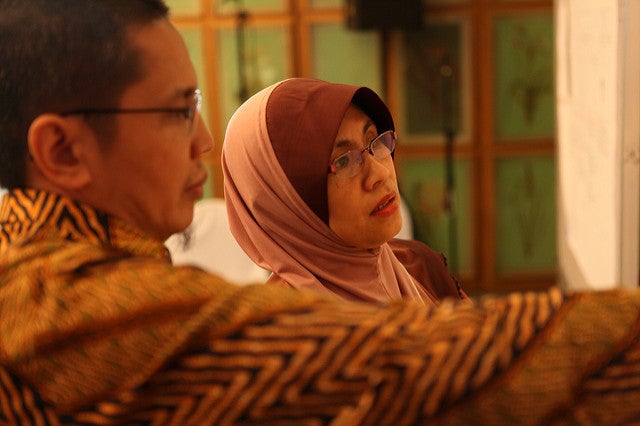
Country core groups are the backbone of the Joint Learning Network for Universal Health Coverage. They help identify country-specific priorities and ensure that the network’s global experience and expertise on health reforms are applied and contextualized at the country level.
What is joint learning?
It goes by a lot of names, including peer-to-peer learning, collaborative learning and joint problem-solving, to name a few. But, basically, it means gathering different groups to address a common challenge and systematically produce new ideas and knowledge.
This may seem like a simple idea, but, with the right country leadership and an effective coordination infrastructure, it can be very effective. It’s also an underutilized concept in global development efforts, which all too often impose technical ideas on countries rather than listening and learning from them.
At Results for Development, we have seen first-hand how powerful this approach can be through our involvement with the Joint Learning Network for Universal Health Coverage. The Joint Learning Network is a community of health policymakers and practitioners from 27 mostly low- and middle-income countries who are working together to collectively develop practical solutions to complex challenges on the road to universal health coverage.
Results for Development helped launch the Joint Learning Network in 2010, in close collaboration with a founding group of countries and partners to help fill a critical gap. Although many countries wanted to move forward with universal health coverage, policymakers and practitioners faced many practical challenges when designing and implementing health-system reforms, and they recognized that many of these challenges were similar from country to country.
So how does it work? And why does it work? And, perhaps most importantly…can the joint learning approach be used to address other tough development challenges?
To be effective, joint learning must be member-driven. This means everything starts and ends with the members — the country participants.
In the case of the Joint Learning Network, everything is country-owned and led. Members identify common technical challenges that multiple countries face; they share and document experiences and strategies to address those challenges; they find knowledge gaps and they co-produce new tools and resources to fill these gaps. All of this happens through multilateral workshops, country learning exchanges and virtual dialogue.
Because the network is member-driven, its activities are highly relevant and useful to the members. Members set the agenda. They are the ones who generate ideas and solutions based on their own practical experiences and their own collective problem-solving. And they use the tools they create, which are more relevant to their needs than tools flown in by outsiders.
Another benefit is that the members feel a great deal of pride and ownership of the network. And because it helps them achieve their goals at home, they’re willing to put their time and energy into driving it forward.
Joint learning requires strong global coordination, strong technical facilitation and a strong digital infrastructure to enable virtual dialogue across the globe.
Joint learning requires active leadership and participation from practitioners in countries, but it also requires strong technical facilitation. Results for Development and several other global partners provide a significant amount of support to Joint Learning Network country members by bringing together topical learning communities, to facilitate their conversations, to find and share relevant global evidence, and to provide the technical guidance and support that busy practitioners need to finalize knowledge products that can be used throughout the network.
Members of the Joint Learning Network report that a key asset of the network is the role played by technical facilitators in helping frame countries’ health reform challenges and working with members to harvest evidence, ideas and experiences in a structured way.
The Joint Learning Network has also invested in a digital infrastructure that enables real-time virtual communication among people from countries around the world, recognizing that global development can benefit from and potentially be transformed by digital social platforms the way that other industries have been transformed.
All of this human and digital infrastructure comes at a cost. Results for Development and the country members and technical partners of the Joint Learning Network are grateful to forward-thinking development partners, such as the Bill & Melinda Gates Foundation, the Rockefeller Foundation, the German Corporation for International Cooperation (GIZ), USAID, and the World Bank, who recognize the value of this model and support it wholeheartedly.
Joint learning requires evidence and iterative learning.
The network is all about translating high-quality research and experience into effective policies and implementation. It focuses on documenting what works and what doesn't — not just in the member countries, but from health systems examples around the world. It positions practitioners, with their deep tacit knowledge, as evidence generators.
Countries often face very different contexts and proposed solutions don’t always work in every situation. The Joint Learning Network increasingly is providing a platform where countries can simultaneously test similar operational approaches and then share the results with one another. This can help to determine context-specific findings versus universal findings. And these findings can be embedded into practical tools that are used in multiple countries.
You can read more about this in a related blog by my colleague, Amanda Folsom: “Turning health systems research and evidence into country action.”
Looking Ahead
We believe that the joint learning model should become a more prevalent part of the global development landscape. In addition to supporting stronger health systems, it can be harnessed to accelerate progress in early childhood education, developing skills for youth, effectively engaging citizens in governance and other areas of our work.
Why could it be the way of the future? Many lower-middle income countries are developing rapidly and transitioning away from donor assistance. These countries are increasingly focused on developing strong health and education systems. But systems strengthening is a complex business with a dizzying number of implementation challenges.
We believe that the expertise to solve these practical challenges resides in the minds and experiences of the people who are working on the frontlines. Future successes in global development will hinge on identifying and sharing their lessons learned.
At Results for Development, we are working closely with our partners around the globe to employ joint learning to address challenges such as:
- How countries dependent on Gavi support can develop strong and sustainable immunization systems and transition to fully self-financing immunization programs?
- How states in Nigeria can create and implement health financing strategies to expand access to and utilization of primary care for the most vulnerable populations?
- How countries can strengthen and support the early childhood workforce to provide children and their families with quality early childhood services?
- How national education systems can develop youth skills for employability in the 21st century economy?
- How country governments and development partners can increase the use of results data to inform critical development decisions?
As the global landscape changes, so must we. It’s vital that we develop, test and scale new promising approaches like joint learning that support local change agents in sharing their expertise, learning from one another and co-producing and adapting innovative solutions.
